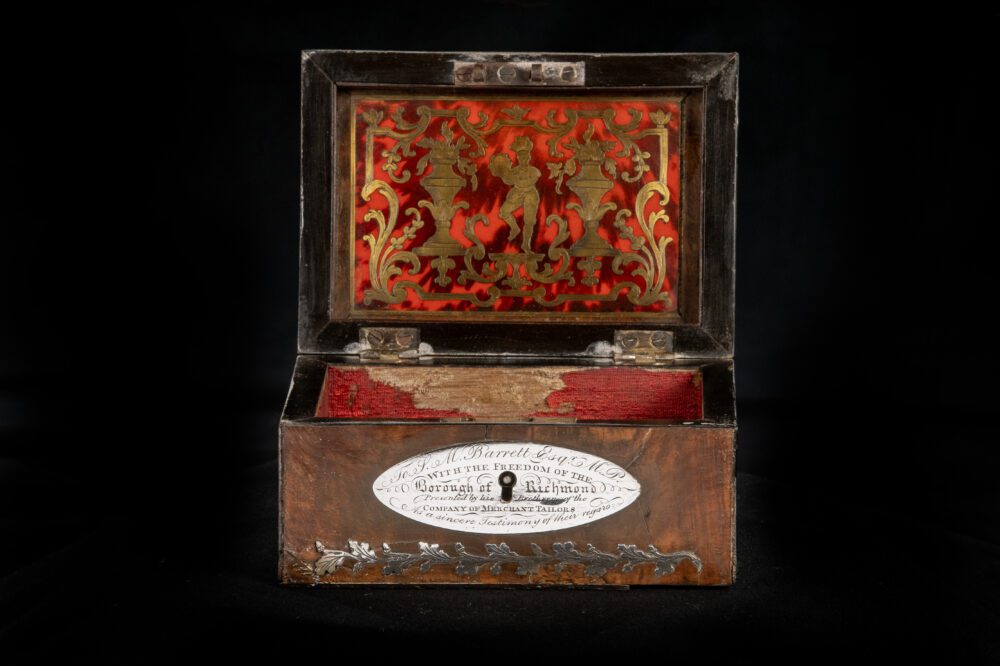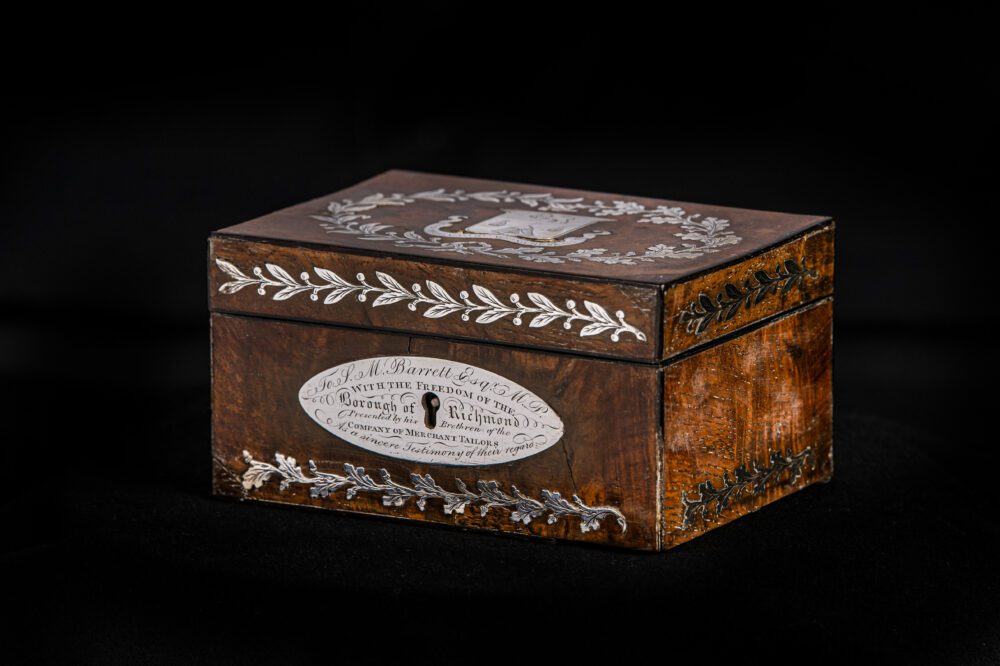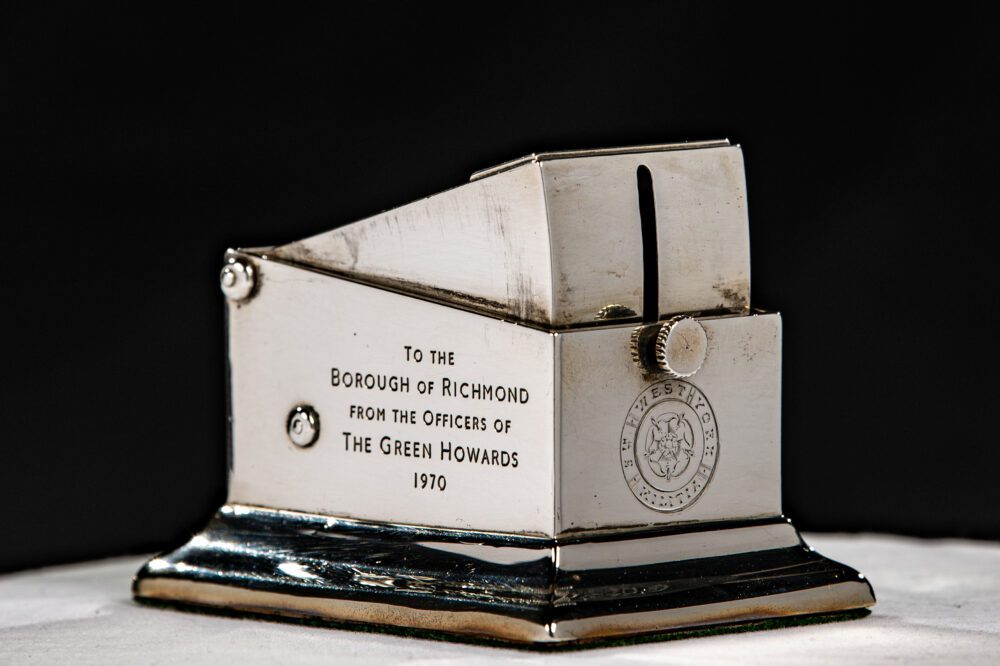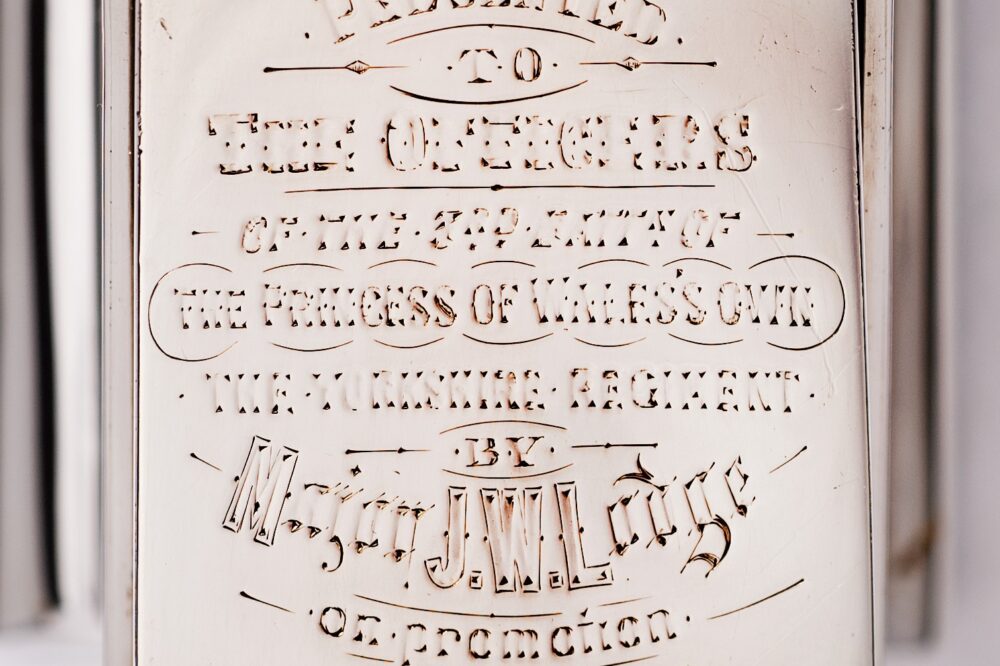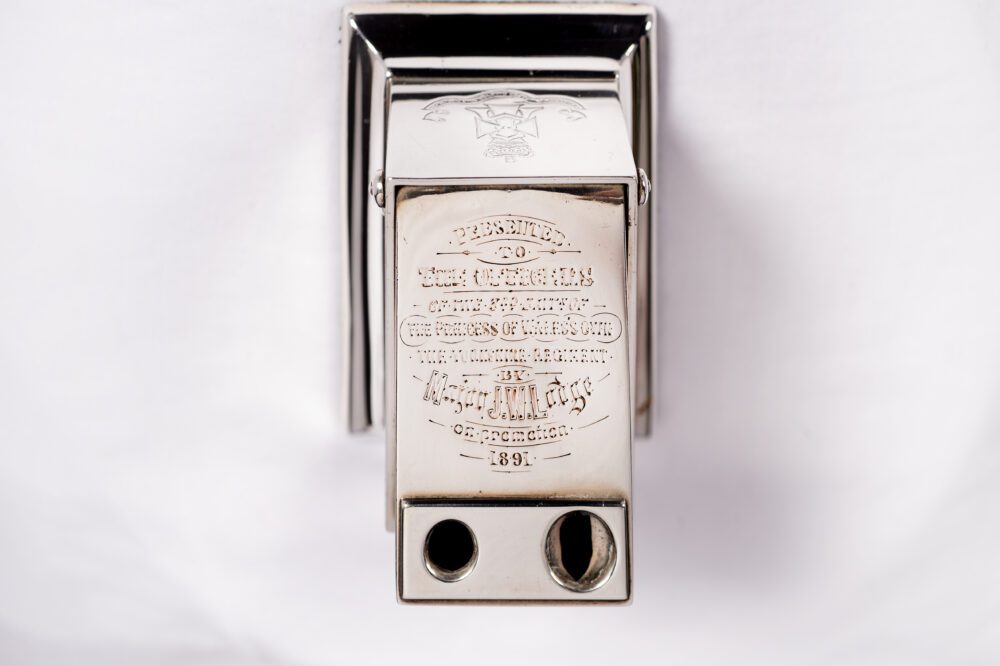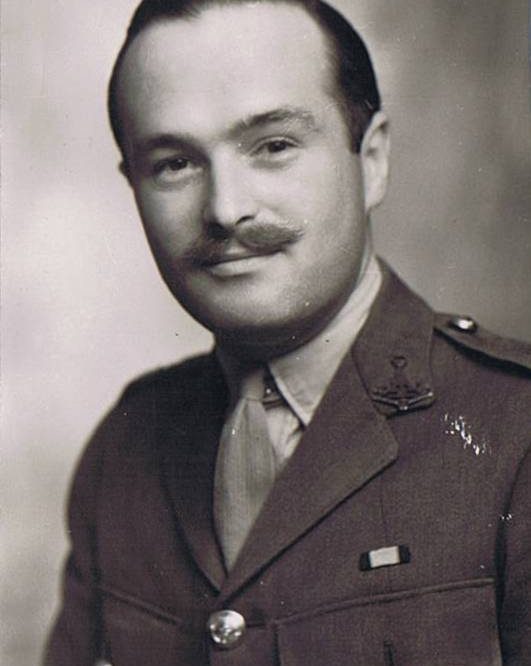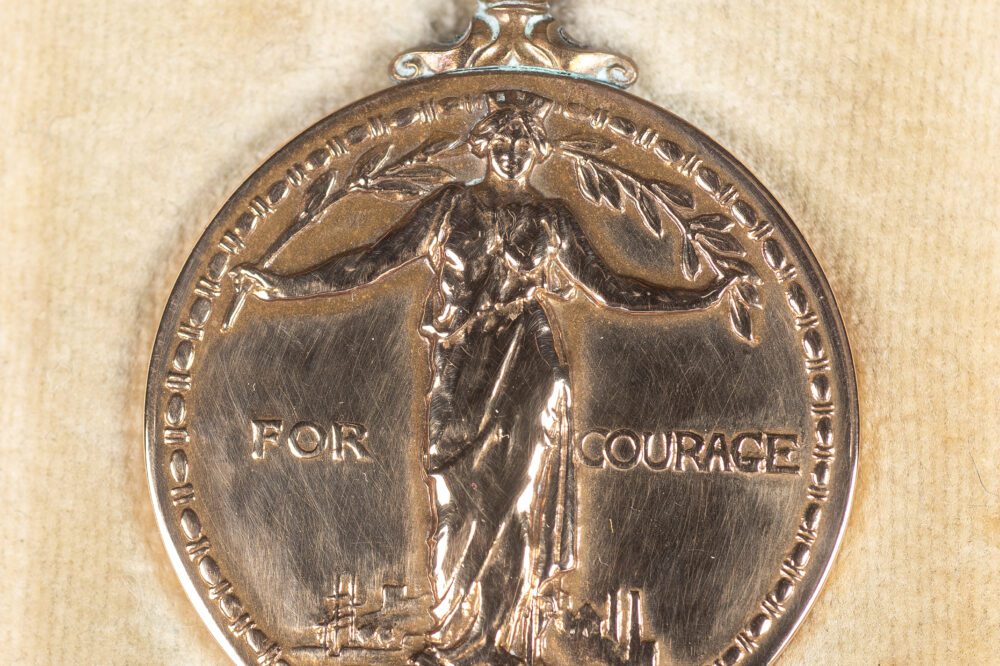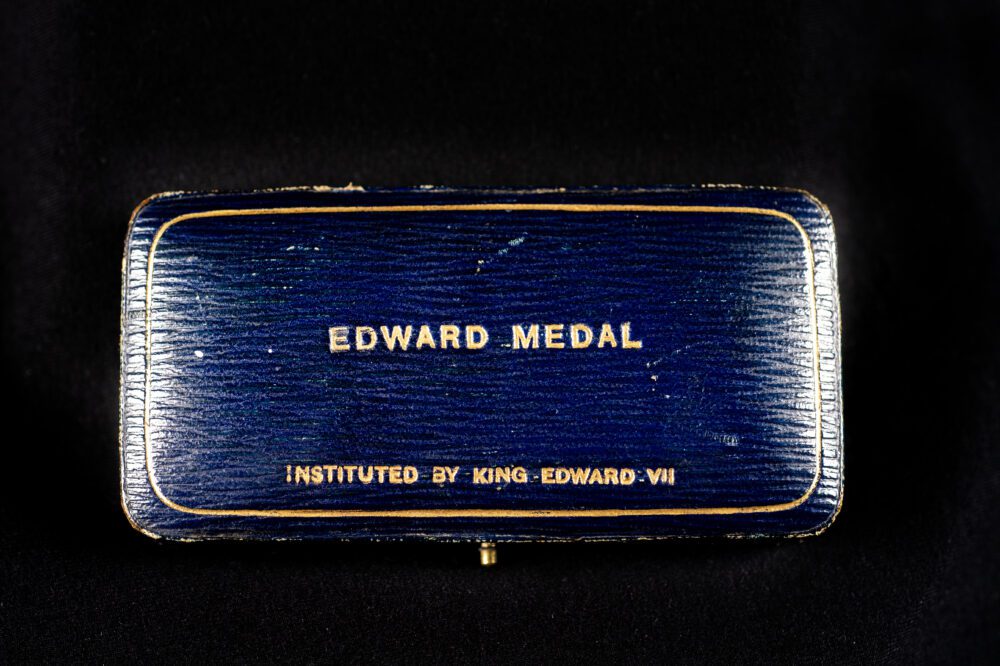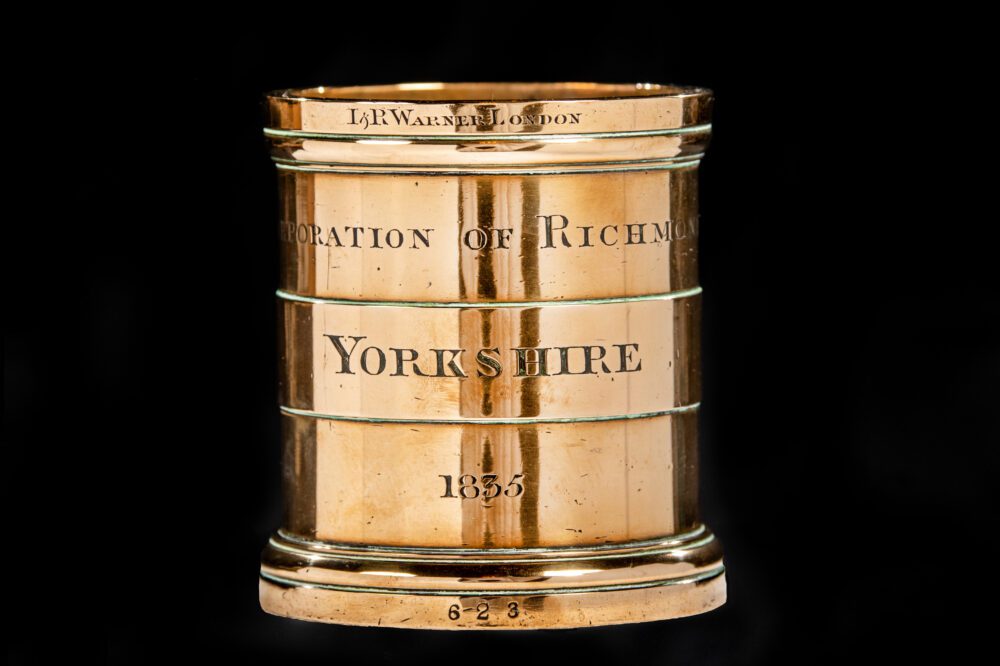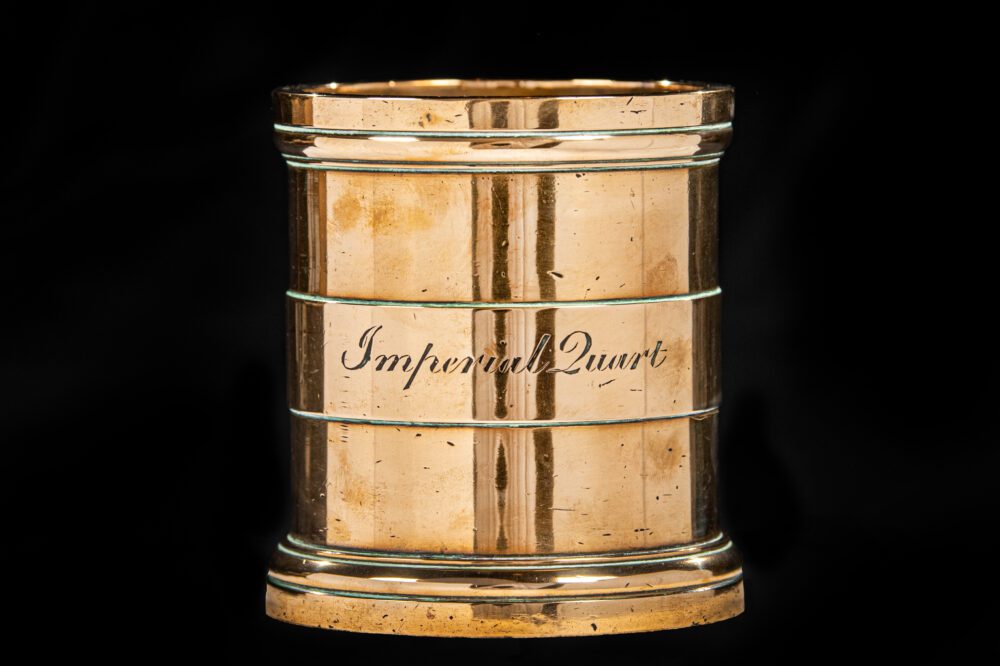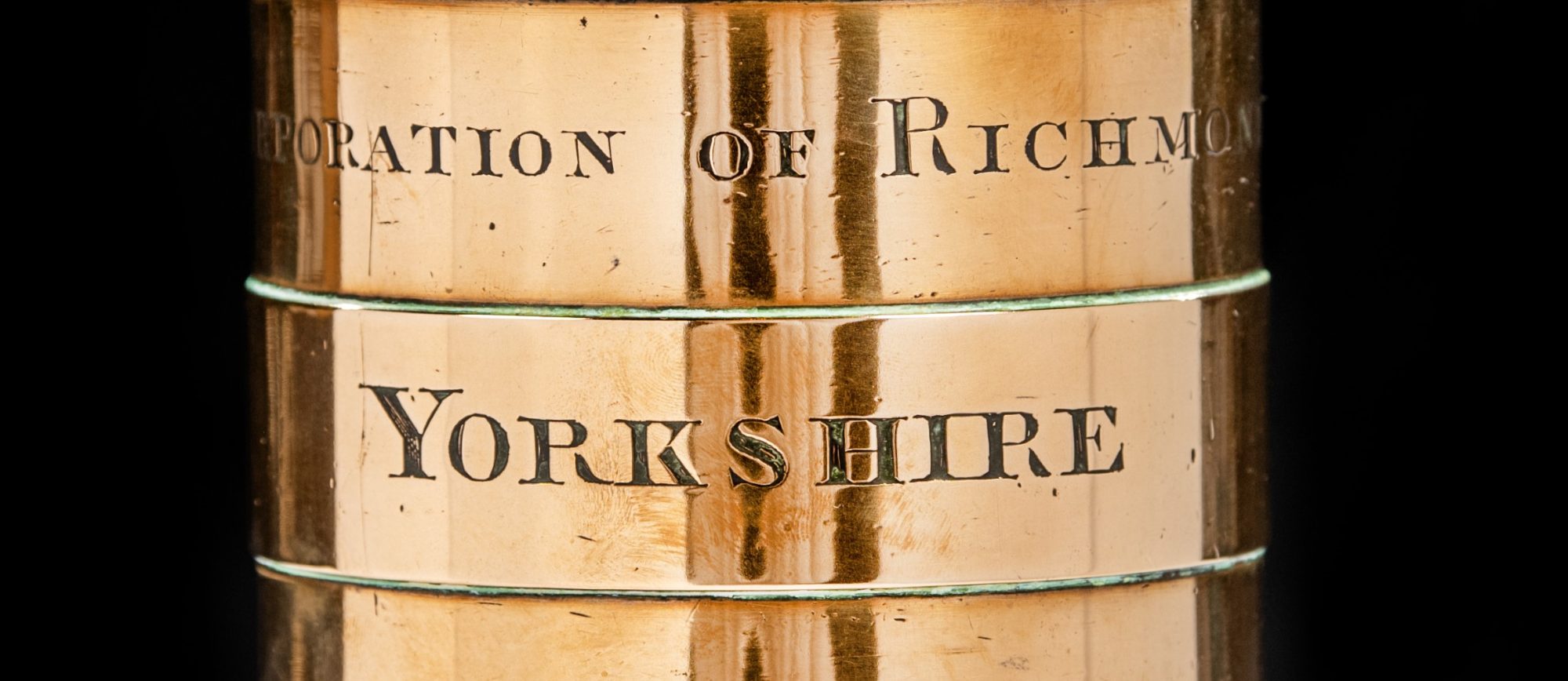
Richmond Town Council: Collection Highlights
A showcase of ten remarkable silverware pieces from the Richmond Town Council collection, each with a captivating story woven into the fabric of the local community. These exquisite artefacts not only display the skilled craftsmanship of their makers but also serve as a window into the rich history and cultural heritage of the town.
These ten incredible items and more from the Richmond Town Council collection are displayed at The Green Howards Museum.
What's in the collection
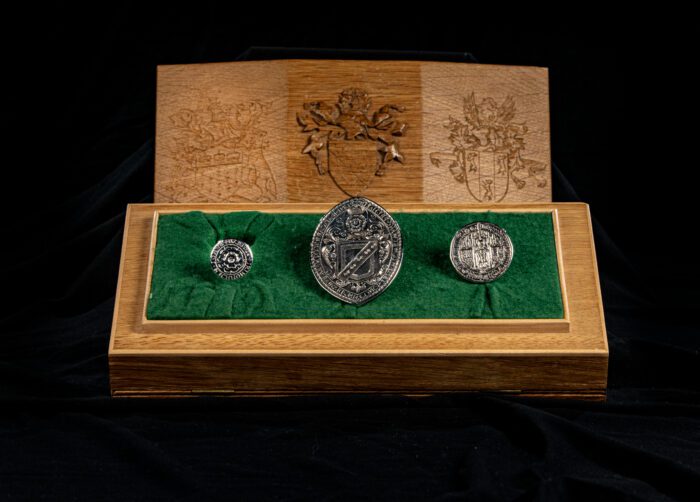
These three seals were used by people in authority who were appointed to decision-making positions within Richmond.
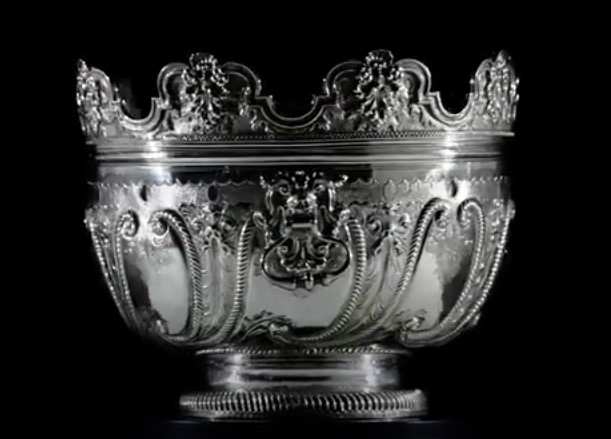
This silver bowl, known as a Monteith, was given by wine merchant and Mayor Cuthbert Readshaw. The scalloped rim of the bowl allows up to 8 wine glasses to be suspended in iced water.
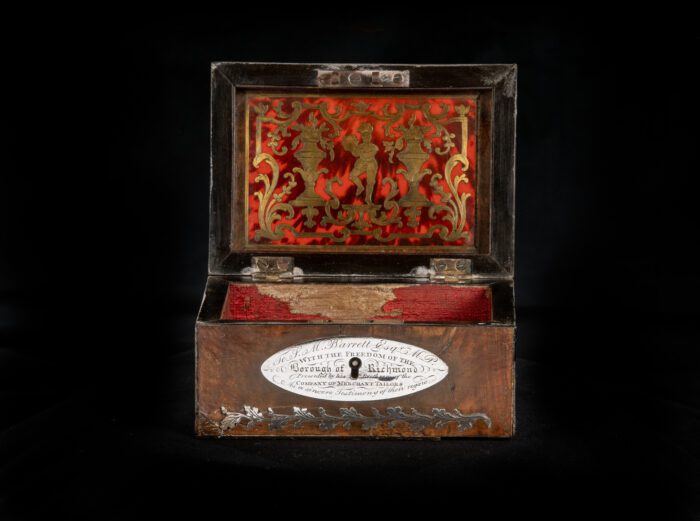
A small, oak casket inlaid with delicate silver oak leaves on all sides. On the lid is the crest of the Merchant Tailors who presented the casket to Samuel Moulton Barratt MP in recognition of him being granted the Freedom of Richmond.
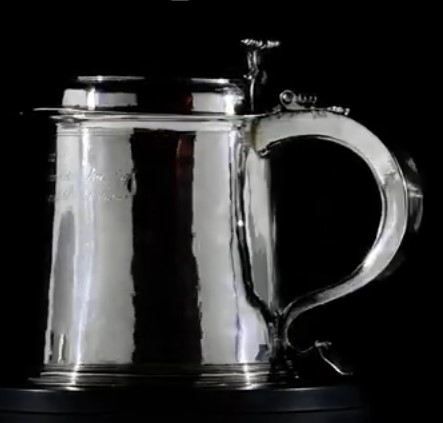
When a snowstorm disrupted a race at Richmond during the 1750s, Mark and John couldn’t agree who won the race. Rather than re-running the race, they agreed to spend the prize money on a piece of silver to be donated to the Corporation of Richmond.
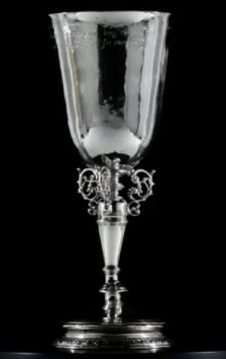
Robert Willance gifted this silver cup to the Corporation of Richmond. It was made 1595-1596 in London by an unidentified goldsmith, and was inscribed at a later date to commemorate the good fortune of his survival from falling off a cliff.
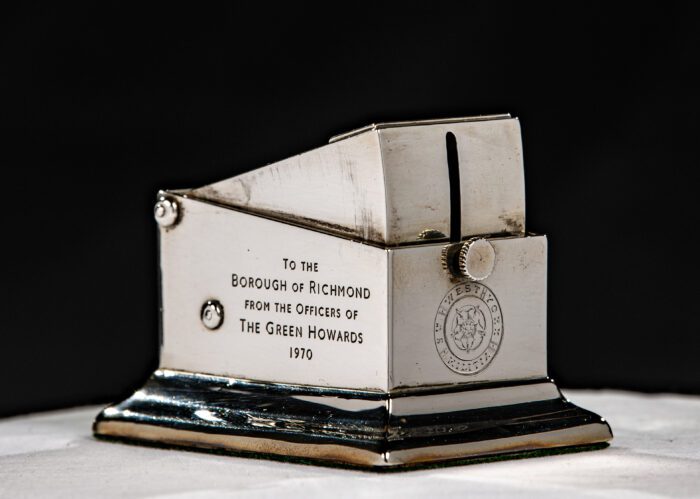
This silver cigar cutter represents the connection between the Green Howards regiment and its home town of Richmond. It was presented to the town on 3rd July 1970 by Colonel John Forbes on behalf of the Green Howards.
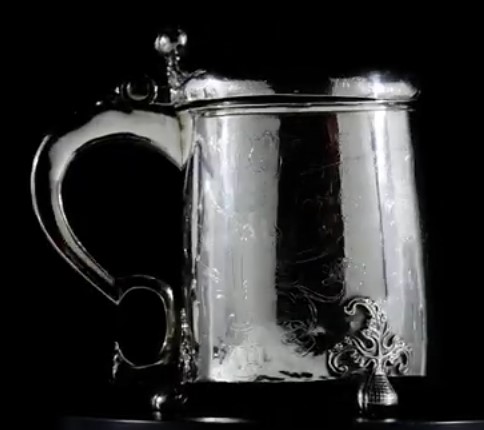
Peg tankards were used to play a drinking game. This one was presented to Richmond Corporation by the first Mayor of Richmond, William Wetwange, on 23rd May 1668.
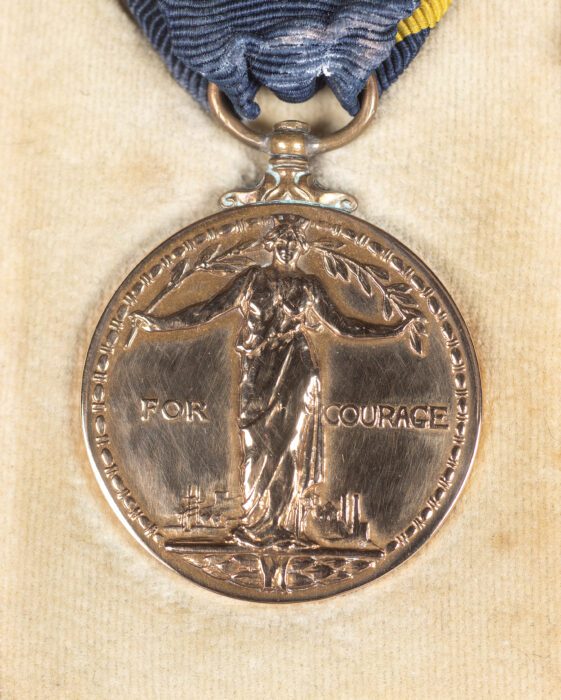
One of the smallest objects in Richmond Town Council’s collection is this bronze medal in a blue leather box. It represents the incredibly brave actions taken by local man John Weller Brown on the 4th February 1944 when ammunition being loaded onto a train exploded.
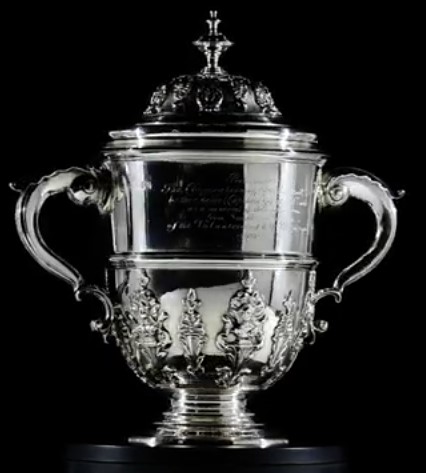
Captain Gerald Walker was serving as Mayor when five local men volunteered for service in the Second Boer War in South Africa. He commissioned and presented this silver cup to the Corporation of the Borough of Richmond to mark their safe return in 1901.
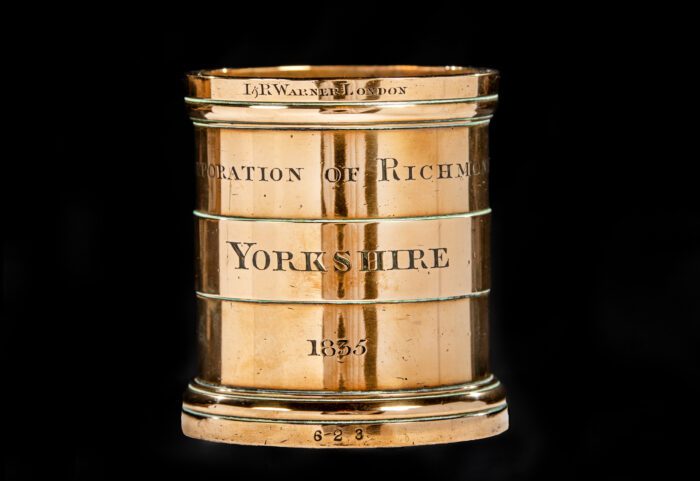
This cup, used at the First Fruits Harvest which takes place on the curtilage around Trinity Church (now the Green Howards Museum). Unusually, the event in Richmond is of a civic rather than religious nature. It was donated to Richmond Town Council by Mr Ralph Waggett in June 2015.
The Richmond Seals
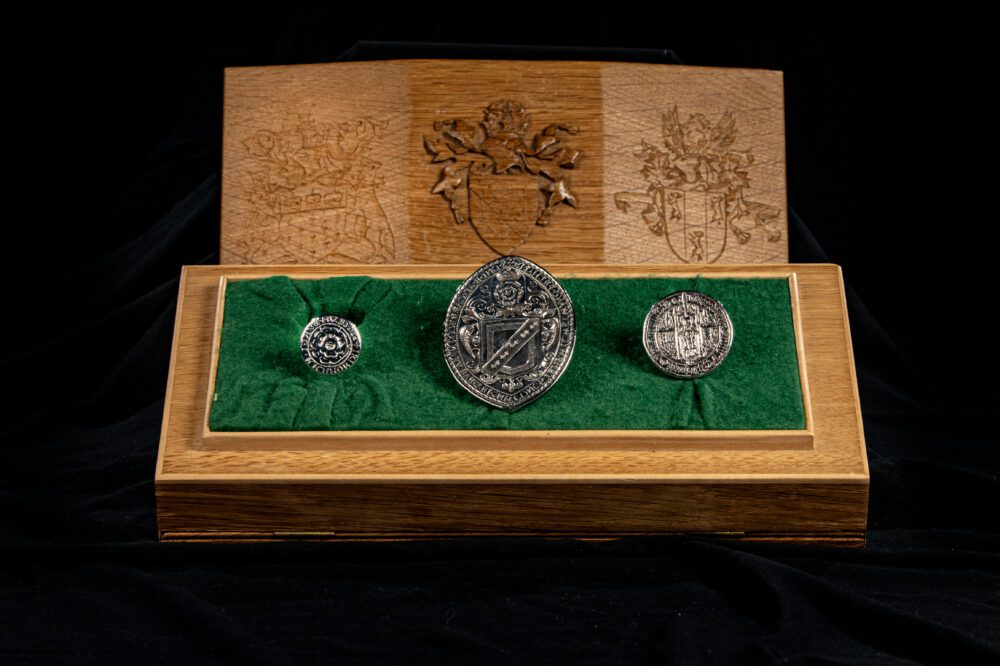
These three seals represent the decision-making authority of the people appointed to official positions within Richmond. The seal is pressed into a soft substance like clay or wax then stamped onto a document to approve decisions.
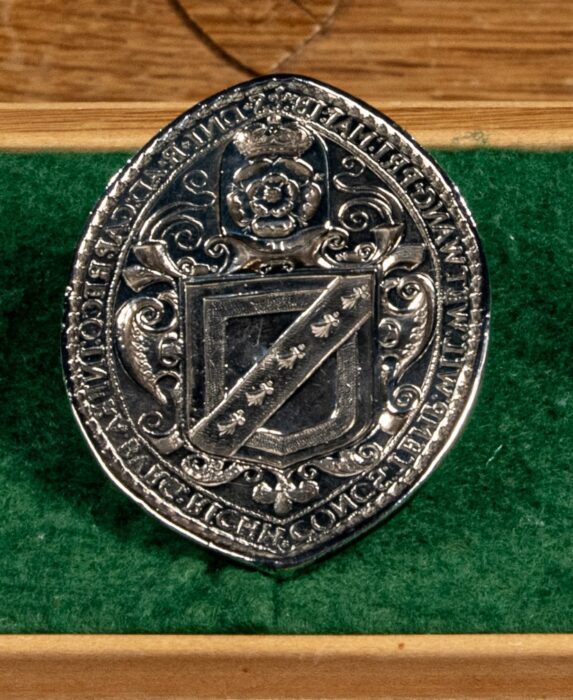
Charles II granted a seal to the Corporation (council) of Richmond in 1668 not long after his position as King was restored. He also approved the creation of a council of 12 Alderman, with 1 leading citizen named Mayor and another named Town Clerk. The seal separates into two sections: the larger part kept by the Mayor and the smaller by the Town Clerk. Both people had to work together in agreement or by compromise to make decisions and seal any official or legal document; thus ensuring that no one person had total authority in the town.
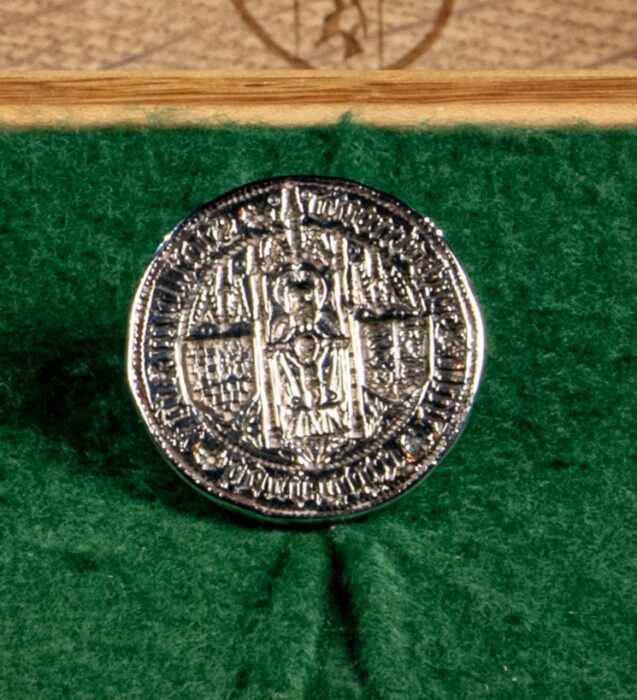
The Common seal is the oldest piece of silver in Richmond Town Council’s collection, likely granted in the early 1400s. It is circular with a depiction of an older man, likely God, with long beard and halo around his head. Two shields complete the design showing the arms of the Earls of Richmond and the Dukes of Brittany.
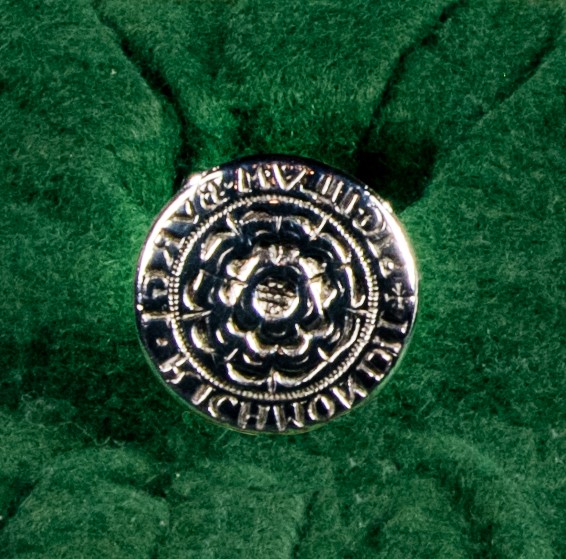
The Lascelles seal is the newest seal in the collection, presented to the Town of Richmond by Sir Thomas Lascelles in 1603. Thomas was an Alderman or council member in Richmond. The seal is inscribed “THIS SEAL WAS GEVEN / TO THE TOWNE OF RICHMOND BY / SER. THOMAS LASCELES / KNYGHT IN THE YEAR OF / V LORD GOD 1603 HE BEINGE / THAN ALDERMAN IN THERE”.
The Crown Bowl
Inscription: RICHMOND NOV.R 4th 1754 / Out of ye great Regards & Affection / I HAVE FOR THIS CORPORATION / I GIVE THIS BOWLE / to be used by the Mayor / for ye time being for EVER. / Cuth Readshaw Mayor.
This silver bowl, known as a Monteith, was used to chill wine glasses. The scalloped rim of the bowl allows up to 8 wine glasses to be suspended in iced water. This particular example has a detachable rim (also called a collar) so that it may also function as a punch bowl.
It was presented to the Corporation of Richmond by Mayor Cuthbert Readshaw in 1754 for use by future Mayors. As a wine merchant he presumably enjoyed using the Monteith during his period in office while Mayor and as an Alderman.
The bowl is decorated with the Common Seal of the Corporation of Richmond on one side and on the other, a stags head holding an oak branch in its mouth, the crest of the Readshaw family.
The bowl, or Monteith, was made by Richard Timbrell (makers mark TI) of Sherborne Lane, London in 1699-1700. Like many goldsmiths at the time he was also a banker. Richard first began working as a goldsmith in 1697 and in the same year he petitioned against the work being produced by Huguenot (French Protestants) goldsmiths who moved to England after the Edict of Nantes in 1685. They brought new styles and skills with them but met resistance from some of their English counterparts.
A small, oak casket inlaid with delicate silver oak leaves on all sides. On the lid is the crest of the Merchant Tailors who presented the casket to Samuel Moulton Barratt MP in recognition of being granted the Freedom of Richmond. The casket contains the original sealed document granting Samuel this honour. The interior of the lid is lined with tortoiseshell inlaid with brass, called boulle work after the French cabinet maker André-Charles Boulle (1642-1732).
The Freedom of a borough, town or city is an honour granted by that town or city to an individual giving them rights and privileges. Freedom of the borough could be granted either by birth, by apprenticeship or by grant from the Council and once granted the individual was known as a Burgess. One of their rights was to sanction decisions, proposals and accounts made by the Mayor and Aldermen. During the 1830s there were approximately 50 free burgesses who were also residents. There were a further 15-20 who were non-resident.
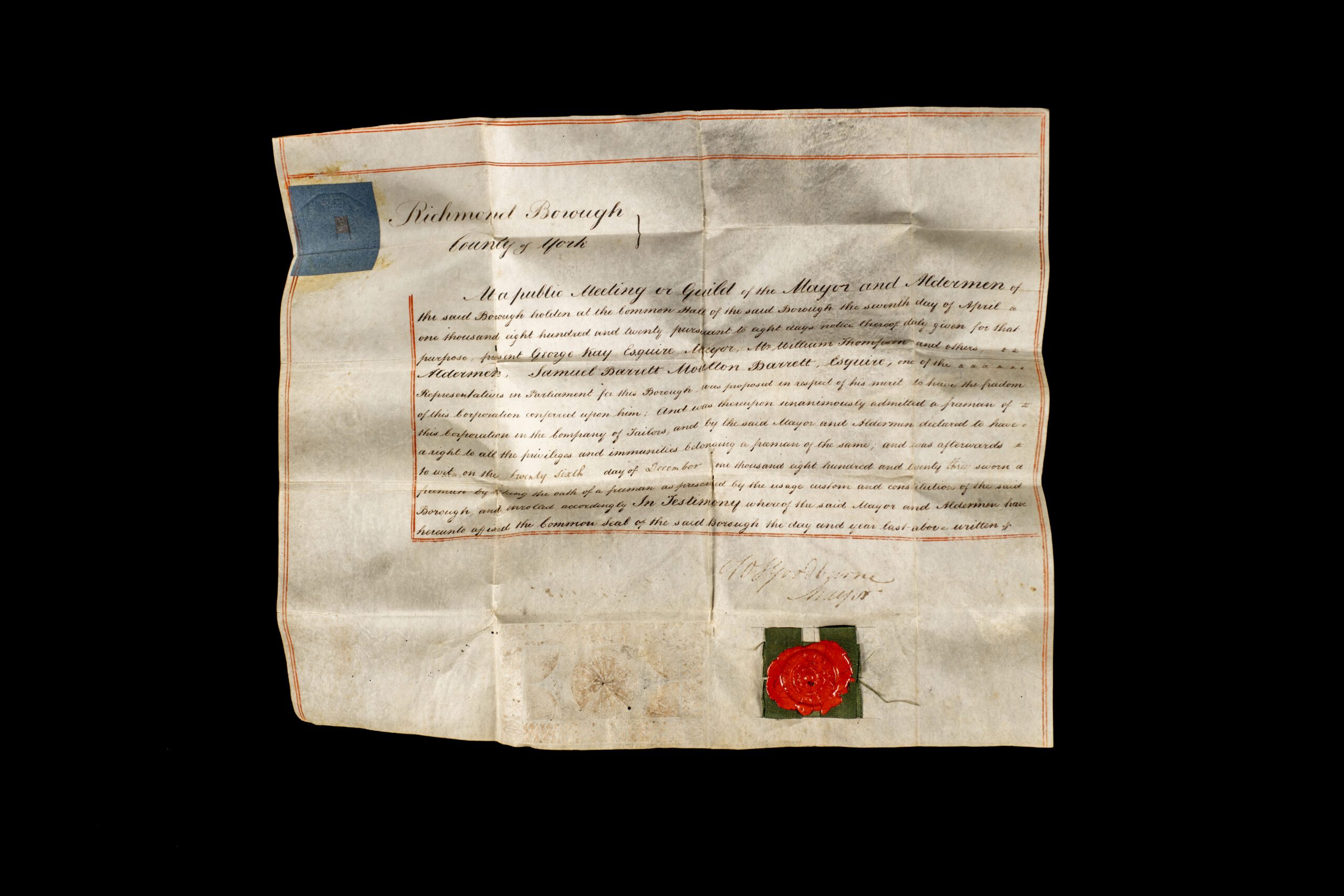
Click here to read the transcription.
Document transcription: Richmond Borough County of York. At a public meeting or Guild of the Mayor and Aldermen of the said Borough holden at the Common Hall of the said Borough on the seventh day of April one thousand eight hundred and twenty pursuant to eight days notice thereof duly given for that purpose, present George Kay, Esquire Mayor, Mr William Thompson and others, Aldermen, Samuel Barrett Moulton Barrett, Esquire, one of the Representatives in Parliament for this Borough, was proposed in respect of his merit, to have the freedom of this Corporation conferred upon him; And was thereupon unanimously admitted a freeman of this Corporation in the Company of Tailors, and by the said Mayor and Aldermen declared to have a right to all the privileges and immunities belonging a freeman of the same; and was afterwards to wit, on the twenty sixth day of December one thousand eight hundred and twenty three sworn a freeman by making the oath of a freeman as prescribed by the usage custom and constitution of the said Borough, and enrolled accordingly In Testimony whereof the said Mayor and aldermen have hereunto affixed the Common Seal of the said Borough the day and year last above written.
Samuel was born in 1787 at Cinnamon Hill, an enslaved labour planation in Jamaica, which he eventually inherited from his brother Edward. Samuel also owned an estate in Britain at Carlton, near Richmond, and he represented the Borough of Richmond in the Houses of Parliament 1820-1827.
Legislation made the trade of enslaved people illegal within the British Empire from 1st May 1807; however this did not grant enslaved people freedom. Emancipation was not achieved until 1838. Incredibly none of those who were freed received compensation while enslaved labour plantation owners did.
According to his biography in the History of Parliament, Samuel faced the contradiction of being an enslaver and a Whig who supported the abolition of slavery. There were 1100 enslaved people at his estates. Even though Samuel abolished the use of the whip, appointed a Black overseer and built houses, schools and churches, they remained enslaved.
When the difficulties of running the estates in Jamaica became more pressing, Samuel moved there, resigning his seat in Parliament in November 1827. Samuel died at Cinnamon Hill, Jamaica, in December 1837.
The Snow Tankard
Inscription: The Snow Tankard / The Gift of Sr Mark Milbanke Bart & John Hutton Senr Esqr / To ye Corporation after a Disputed Race in a great Snow at Easter.
If you’ve ever been to court over a dispute, you’ll know how expensive that can be. Sir Mark Millbank of the Barningham Estate and John Hutton of Marske put their money to better use following a disagreement.
When a snowstorm disrupted a race in Richmond during the 1750s, Mark and John couldn’t agree who won the race. Rather than re-running the race, they agreed to spend the prize money on a piece of silver to be donated to the Corporation of Richmond.
The race was run at Richmond Racecourse, an oval shaped course which saw races as early as 1512. From the mid-18th century onwards it included a stone-built grandstand which enabled spectators to view the entire course while protected from the unpredictable Yorkshire weather. As horses were bred to become stronger and faster, the Richmond racecourse, with its tight turns, eventually became unsafe to run and closed in the 1890s.
The tankard was made 1686-1687 by Marmaduke Best from the parish of St Michael’s, Spurriergate, York who is considered one of the finest goldsmiths from the city. It was not uncommon for pieces of silver to be repurposed and engraved with inscriptions at a later date.
The Willance Cup
Inscription: This boulle given by Robert willance to the Incorporated Allderman and Burgagsses of Richmond, to be used by the Alderman for the tyme being. And to be redelivered by him to his exer or Assignes to his Successors for ever. 1606.
High above Whitcliffe Scar, above the north bank of the River Swale, is Willance’s Leap. A bridle path follows the top of the Scar where, in 1606, Robert Willance was out hunting. As an unexpected fog closed in, the horse bolted, plunging with its rider over the cliff to fall 212 feet to the rocks below. The horse, killed in the fall, cushioned Robert’s landing although he suffered a terrible injury to his leg, which was later amputated. Robert Willance was the first Alderman of Richmond in 1608, he was also a prospector in the local lead mines, as well as a wealthy draper.
Robert gifted this silver cup to the Corporation of Richmond. The cup has a plain silver bowl above a knopped stem (globular ornament mid-way on the stem) decorated with 3 scrolls and a raised decorated foot. It was made 1595-1596 in London by an unidentified goldsmith (markers mark AB within a shield over a tun or wine cask). It was inscribed at a later date to mark the good fortune of his survival.
This silver cigar cutter represents the connection between the Green Howards regiment and its home town of Richmond. It was presented to the town on 3rd July 1970 by Colonel John Forbes on behalf of the Green Howards.
It had originally been presented to the 3rd Battalion The Princess of Wales’s Own The Yorkshire Regiment (a previous name for the Green Howards regiment) by Major John Lodge when he was promoted in 1891. The cigar cutter was made by William Gibson and John Langman of Regents Street, London in 1890, who co-owned a large jewellers and silversmith retailer from 1880-1898.
“A large and enthusiastic crowd met him at the station, the West Burton Band playing appropriate airs. After much hand shaking and cheering, Mr Tomlinson in an admirable speech welcome Colonel Lodge back to Wensleydale…After Colonel Lodge replied, giving a most interesting sketch of what he had had to do in South Africa, the band headed the procession from the station, Colonel Lodge riding in a wagonette with his sisters.” – The Aysgarth parish magazine reporting upon his return from service in the 2nd Boer War (1899-1902).
John came from a prominent family who lived at The Rookery Bishopdale near Aysgarth. He joined the Yorkshire Regiment in 1881. During World War I John returned to military service and was appointed command of a Garrison Battalion. Outside of his military career John was a Justice of the Peace, a skilled angler and marksman. He never married or had children. John died at home on 23rd August 1917 aged 60, not long after Rowland Henry Hill completed his portrait which now hangs in The Green Howards Museum.
The Peg Tankard
William Wetwange was the first Mayor of Richmond following the charter issued by King Charles II in 1668. The Corporation was made up of 12 Aldermen, one of whom became the Mayor and served for one year. Each year, two Aldermen would be selected to be potential mayoral candidates. The Freemen of the Borough, mostly members of the 13 trade companies or guilds, would vote for their preferred Mayor. William took office on 23rd May 1668 and he presented this silver Peg Tankard to commemorate his appointment.
Peg tankards were used to play a drinking game. Eight equally distanced pegs inside the tankard measure the amount that each person was to drink as the tankard was passed around. Peg tankards often rest on pomegranate-shaped feet and have a thumbpiece at the top of the handle, also shaped like two pomegranates. William’s peg tankard is also decorated with a tulip, a daisy and a rose, with two figures each emerging from flower heads to fight monstrous creatures. The figures are arranged in fighting pairs: a man fights a stylised wolf with a spear, while a woman defends herself with a shield from a satyr.
The designs featured on the tankard find inspiration from Scandinavia, where examples also feature the pomegranate feet and beautifully balanced botanical engravings. The close cultural connection between the North of England and Scandinavia is evident in the local taste for the Scandinavian drinking style. Very often the tankards feature the arms of the families purchasing from him. This example features William’s arms which includes a porcupine.
The earliest and finest examples of these tankards were made by John Plummer (makers mark IP), a goldsmith from Coney Street, York who made this example in 1664-1665. He specialised in making peg tankards and examples may be found in other museums including the V&A. John was also paid £26 2s 6d in 1674-1675 for making a new mace for Richmond Corporation as well as adding a crown to the earlier Commonwealth mace which had originally been created by his father.
One of the smallest objects in Richmond Town Council’s collection is this bronze medal in a blue leather box. It represents the incredibly brave actions taken by local man John Weller Brown on the 4th February 1944 when ammunition being loaded onto a train exploded.
John, aged 24, was an army haulage contractor, who had just delivered a lorry containing ammunition to Catterick Bridge Railways Station. The explosion threw John a considerable distance, killing 12 people including 6 civilians and injuring 102. The explosion was felt for miles around with the windows of buildings within a ½ mile radius being blown out. The cause of the explosion is believed to be mishandling of ammunition, although at the time speculation was rife as wartime censorship limited reporting.
When John came to, he and another man immediately began to help the injured before assisting the Fire Brigade, at great risk to himself. Fires had broken out around the explosion crater within 50 yards of at least three further lorries full of grenades.
John was recommended for the Edward Medal by the General Officer Commanding (GOC) of Northern Command, Lieutenant General Sir Ralph Eastwood. There are two versions of the medal, for mining and for industry; the latter of which John was awarded.
Click here to read the citation for the award.
“The King has been pleased to award the Edward Medal to John Weller Brown, in recognition of his gallantry in the following circumstances:- when a violent explosion took place at an ammunition railhead. Mr. Brown was in a hut 40 yards away. The hut collapsed and he was blown a considerable distance. The explosion was followed immediately by extensive fires in the surrounding area, caused mainly by grenades and incendiary bombs scattered from adjoining trucks. Mr Brown, though badly shaken, returned to the hut, which was already on fire. He was joined by another, who, though injured himself, was able to assist him to extricate three other injured men from the ruins of the hut and to carry them to safety. They then assisted in the rescue of killed and injured from other burning and wrecked buildings. Mr Brown continued the work until emergency parties had arrived and taken over the work of rescue and fire fighting. Mr Brown well knew that the area contained other loads of high explosives which might well have exploded. His behaviour showed courage, initiative and determination of a high order.”
– The London Gazette on 9th June 1944
The South Africa Cup
Inscription (front): Presented to The Corporation of Richmond Yorks. by the Mayor (Captain Gerald Walker) / as a memorial of the safe return / from South Africa / of the Volunteers of that Borough / 1901
Inscription (back): Corporal B. J. Walker, 40th. Coy 10th. Battn. Imperial Yeomanry / Corporal T. H. Todd. Volunteer Special Service Coy. Yorkshire Regiment / Private T. W. Stevenson. Volunteer Special Service Coy. Yorkshire Regiment / Private H. Brooksbank. Volunteer Special Service Coy. Yorkshire Regiment / Trooper Alfred Barker, 66th Company Imperial Yeomanry
The First Boer War (1880-1881) and the Second Boer War (1899-1902) were fought between Great Britain and the two Boer (or Afrikaner) republics; the South African Republic and the Orange Free State. Afrikaners are descended from Dutch settlers who arrived in South Africa from 1652 onwards. Although outnumbered, the Boers were highly skilled and determined to resist British expansion.
This war was the first time British people across society took up arms and volunteered, in great numbers, to serve. Many of them, like Corporal Walker and Trooper Barker, joined the newly created Imperial Yeomanry. Corporal Todd and Privates Stevenson and Brooksbank joined a Volunteer Company of the Yorkshire Regiment (Green Howards).
Captain Gerald Walker was serving as Mayor when five local men volunteered for service in the Second Boer War in South Africa. He commissioned and presented this silver cup to the Corporation of the Borough of Richmond to mark their safe return in 1901. It was made in London by Mappin Bros.
Click for more information on the Boer War.
Fighting was bitter and, after a long period of guerrilla warfare, British victory was gained through controversial tactics. Concentration camps were introduced in 1900. With poor accommodation, limited supplies and facilities sickness was widespread resulting in the deaths of 28,000 people, mainly women and children. It was hoped that this tactic would remove support for fighters and cause them to stop fighting in order to save their families.
This tactic was flawed however. It instead enabled fighters to concentrate on fighting and caused widespread criticism in Britain and abroad.
The Boer’s eventually sought terms for peace following a ‘scorched earth’ policy and following the release of their families from the camps. British soldiers were told to leave Boer families to be cared for by the enemy which hampered Boer mobility.
On 31st May 1902 they signed the Treaty of Vereeniging, accepting British rule with limited self-government.
The Corn Cup is used during the First Fruits Harvest which takes place on the second Saturday in September. The event is led by the Mayor and takes place on the curtilage around Trinity Church (now The Green Howards Museum). A local farmer will bring a sample of grain to weigh using the Corn Cup. The inspector examines the corn and declares the harvest good or bad. If the harvest is good, the group drink a toast.
The First Fruits Harvest, or something similar features in almost every religion around the world, where thanks are given to God, gods or deities for the food grown in preparation for winter. Unusually, the event in Richmond is of a civic rather than religious nature. The Corporation of Richmond made income from tolls when the harvest was brought to market to be sold. The corn trade in the 1830s was economically vital, with a large proportion of farming land ploughed to produce corn for flour. This corn cup is brass and takes a measurement of volume called a Quart (a little more than 1 litre). It was made by J Warner & Sons, London and used from 1835 onwards.
Each time farmers came to market, they were expected to pay a toll from the goods they brought. Toll collectors with large bags measured out the required toll using tin scoops according to the amount being transported. Farmers would often bring surplus grain in a separate sack so that they did not have to open the weighed and tested bags.
Corn harvesting required a vast amount of labour with men, women and children assembling at 7am at Frenchgate Head to form yans (teams) of four people; three shearers and one binder. Once gathered the corn was hung in every nook and cranny to dry it before it was prepared for milling. The vast stores of flour produced allowed householders to make it through the winter when work was scarce and wages small.

